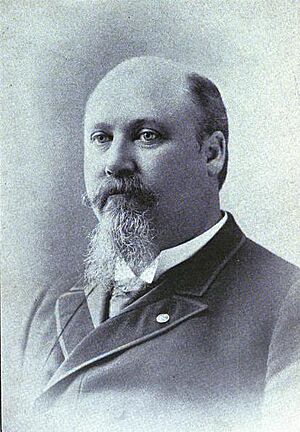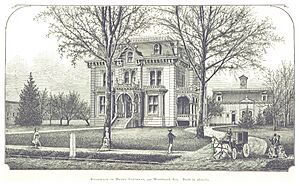Hazen S. Pingree facts for kids
Quick facts for kids
Hazen S. Pingree
|
|
|---|---|
 |
|
| 24th Governor of Michigan | |
| In office January 1, 1897 – January 1, 1901 |
|
| Lieutenant | Thomas B. Dunstan Orrin W. Robinson |
| Preceded by | John Treadway Rich |
| Succeeded by | Aaron T. Bliss |
| 43rd Mayor of Detroit | |
| In office 1889–1897 |
|
| Preceded by | John Pridgeon Jr. |
| Succeeded by | William Richert |
| Personal details | |
| Born | August 30, 1840 Denmark, Maine, U.S. |
| Died | June 18, 1901 (aged 60) London, England |
| Nationality | American |
| Political party | Republican |
| Spouse | Frances Gilbert |
| Signature | |
Hazen Stuart Pingree (born August 30, 1840 – died June 18, 1901) was an important American leader. He was a successful businessman and a member of the Republican Party.
Pingree served as the 43rd Mayor of Detroit from 1889 to 1897. After that, he became the 24th governor of Michigan from 1897 to 1901. He was known for fighting against powerful companies and helping ordinary people.
He became mayor in 1889 and was reelected three times. He often warned about the dangers of big companies that controlled everything. He worked to lower prices for things like streetcars, gas, and electricity in Detroit. He also pushed for the city to own its own electric plant. This made him very popular.
During a tough economic time called the Panic of 1893, Pingree started a "Potato Patch Plan." This allowed poor people to grow food on empty city land. He even sold his own horse to help pay for tools and seeds. Pingree was a Republican who also supported ideas popular with working-class people. He is remembered as one of the best mayors in American history.
Contents
Early Life and Military Service
Where Was Hazen Pingree Born?
Hazen Pingree was born in Denmark, Maine. His parents were Jasper and Adeline Pingree. When he was 14, he worked in a cotton factory in Saco, Maine. Later, he moved to Hopkinton, Massachusetts, and worked in a shoe factory.
Pingree's Role in the Civil War
In 1862, Pingree joined the Union Army during the Civil War. He fought with the 1st Massachusetts Heavy Artillery Regiment. He was part of major battles like the Second Battle of Bull Run.
His regiment helped defend Washington, D.C. Later, they returned to the front lines. He fought in battles such as Harris Farm and Spotsylvania Court House.
Pingree was captured by Confederate soldiers. He was held in several prisons, including Andersonville prison. He managed to escape by pretending to be another prisoner during a prisoner exchange. After escaping, he rejoined his regiment. He was present when Robert E. Lee surrendered, ending the war.
Business Success in Michigan
How Pingree Built a Shoe Empire
After the war, Pingree moved to Detroit, Michigan. He was a cobbler, meaning he made and repaired shoes. In 1866, he started his own company, Pingree and Smith.
His business grew very quickly. By 1886, it was a huge company worth $1 million. They had 700 employees and made half a million shoes and boots each year. It became the second-largest shoe manufacturer in the United States. Even after a fire destroyed their factory in 1887, they rebuilt and recovered.
Pingree's Family Life
In 1872, Hazen Pingree married Frances A. Gilbert. She was from Mount Clemens, Michigan. They had three children: Joe, Hazel, and Gertrude. Sadly, Gertrude passed away at age 19.
Mayor of Detroit: Fighting for the People
Becoming Mayor and Battling Monopolies
Hazen Pingree had not been involved in politics before. But in 1889, he ran for mayor of Detroit. He promised to stop corruption in city contracts. He quickly started fighting against private companies that held monopolies. These companies controlled essential services like electricity and gas.
He tried to create city-owned companies to compete with them. His biggest fight was with the streetcar company. He wanted to lower their fares to three cents. He even tried to create a city-owned railway, but the state law prevented it.
Helping Citizens During Hard Times
During the severe nationwide depression of 1893, Pingree helped many people. He expanded public welfare programs. He also started public works projects to give jobs to the unemployed. He built new schools, parks, and public baths.
He became famous for his "potato patch plan." This allowed poor people to use 430 acres (about 174 hectares) of empty city land. They could grow their own food there. He believed in ideas that helped ordinary citizens.
Historians and experts have ranked Pingree as one of the best mayors in major American cities.
Governor of Michigan: Progressive Reforms
From Mayor to Governor
In 1896, Pingree was chosen to run for Governor of Michigan. He promised to bring prosperity to everyone. He won the election and also helped William McKinley win the presidential election in Michigan.
He took office as governor on January 1, 1897. He initially wanted to finish his term as mayor of Detroit too. However, the Michigan Supreme Court ruled that he could not hold both jobs. So, Pingree resigned as mayor.
Pingree's Progressive Ideas as Governor
During his four years as governor, Pingree pushed for many changes. He wanted to regulate railroad prices. He also wanted to make sure big companies paid fair taxes. He believed cities should own public services like water and electricity.
He supported several "progressive" ideas. These included letting citizens directly elect U.S. senators. He also wanted an eight-hour workday and an income tax. He supported primary elections, where voters choose candidates. He also wanted to end child labor.
Many of his ideas faced opposition from other politicians and business leaders. Pingree often spoke about his fear of too much corporate power. He said, "I do not condemn corporations and rich men, but I would keep them within their proper spheres." He believed the government should not be controlled by powerful financial interests.
Death and Legacy
The End of a Life of Service
Pingree did not run for reelection as governor in 1900. In 1901, he was returning from a trip to Africa with his son. He became very ill in London, England, with an infection called peritonitis. He was unable to return home. Even King Edward VII, who looked a lot like Pingree, sent his own doctors to help him.
Hazen Pingree passed away on June 18, 1901.
Remembering Hazen Pingree
Pingree was first buried in Elmwood Cemetery in Detroit. Later, he was reinterred at the Woodlawn Cemetery in Detroit.
There is a statue of Hazen Pingree in Grand Circus Park in Detroit. It honors him as "The Idol of the People." This statue was created by an Austrian sculptor named Rudolph Schwarz.

You can also find a bronze bust of him in the Coleman A. Young Municipal Building in Detroit.
See also



